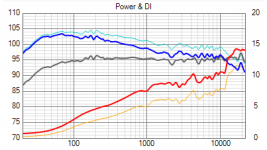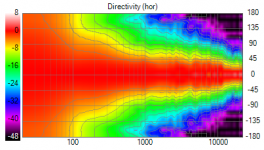Dear diyAudio forum,
I’m browsing for a 15” driver and I’m finding that they can vary quite a bit in their frequency range, I find this a bit surprising.
How come two same-size drivers can have a different frequency range, i.e. one has 50-4000Hz while the other has 38-1800Hz?
What determines the low and high cutoffs if they’re the same size?
Many thanks,
Simon
I’m browsing for a 15” driver and I’m finding that they can vary quite a bit in their frequency range, I find this a bit surprising.
How come two same-size drivers can have a different frequency range, i.e. one has 50-4000Hz while the other has 38-1800Hz?
What determines the low and high cutoffs if they’re the same size?
Many thanks,
Simon
Frequency RANGE is determined by the marketing department.
Frequency RESPONSE is the truth the marketing department don't want you to know as its expressed from physically testing the driver.
Frequency RESPONSE is the truth the marketing department don't want you to know as its expressed from physically testing the driver.
"How come two same-size drivers can have a different frequency range"
Like any product its how and what its made from and how the maker has implemented it... a base model ford mondeo isnt no GT Mustang but their near the same size and made from the same materials.
Like any product its how and what its made from and how the maker has implemented it... a base model ford mondeo isnt no GT Mustang but their near the same size and made from the same materials.
At the top end, typically it's when the response falls off a cliff after any cone breakup peaks. Occasionally, a sensible manufacturer will spec the upper cutoff before the cone breakup, if it's really severe. See Seas aluminium cones for example.
At the bottom end, it's usually Thiele-Small based, with Fs often being used as the lower cutoff.
Of course, any driver can produce 1Hz, but some can do it louder than others.
Chris
At the bottom end, it's usually Thiele-Small based, with Fs often being used as the lower cutoff.
Of course, any driver can produce 1Hz, but some can do it louder than others.
Chris
The former will likely have a less massive cone compared to the latter, resulting in a higher bass resonant frequency which limits its low bass response.How come two same-size drivers can have a different frequency range, i.e. one has 50-4000Hz while the other has 38-1800Hz?
The former's less massive cone will also have a smaller inertia (opposition to acceleration) which allows it to respond more readily to higher frequency signals.
Usually mass of cone.
Obviously size comes into it because typically larger cone and bigger mass.
Having said that Fane get away with up to 17KHz with a 12 inch driver by using whizzer cones. So it can be quite complicated.
Obviously size comes into it because typically larger cone and bigger mass.
Having said that Fane get away with up to 17KHz with a 12 inch driver by using whizzer cones. So it can be quite complicated.
Voice coil inductance? Optimizing for low frequency power handling would sacrifice the high frequencies. You can have both but then there won't be too much powerhandling capability due to "wimpy" voice coil. 15" speaker don't have to play much higher than 1khz-2khz because if you care about smooth in room response response you'd want to crossover to a smaller driver lower than that anyway.
i thought it was three parameters:
- target system sensitivity power handling and box size volume which all depends on the application (indoor, outdoor, club/cinema or car?).
- resonance frequency of the cone material itself; determines where it no longer sounds OK in the top end and needs to be filtered.
- resonance frequency of the whole moving cone system "motor" (cone size, weight, spider resistance, surround type, coil size, magnet gap length) defines typically the -3dB low end roll off.
some drivers are very good at one specific thing while others are more all round usage, all are built on compromise in design decisions with its target audience I believe all vendors want to make money (cost/benefit in the market).
some drivers also have special features for weight or robustness for very specific usuage which typically increase the price more than what it would make sense for a normal person to pay for in DIY; example aluminum die cast chassis and neo magnets doesn't necessarily have much impact on sound but will dramatically improve the workload of a mobile PA - yet since these desings cost more to begin with also more attention are given to the cone and motor design, resulting in a overall slightly better driver but to 4x cost.
well in my head at least, im very subjective in my understanding and have no references
- target system sensitivity power handling and box size volume which all depends on the application (indoor, outdoor, club/cinema or car?).
- resonance frequency of the cone material itself; determines where it no longer sounds OK in the top end and needs to be filtered.
- resonance frequency of the whole moving cone system "motor" (cone size, weight, spider resistance, surround type, coil size, magnet gap length) defines typically the -3dB low end roll off.
some drivers are very good at one specific thing while others are more all round usage, all are built on compromise in design decisions with its target audience I believe all vendors want to make money (cost/benefit in the market).
some drivers also have special features for weight or robustness for very specific usuage which typically increase the price more than what it would make sense for a normal person to pay for in DIY; example aluminum die cast chassis and neo magnets doesn't necessarily have much impact on sound but will dramatically improve the workload of a mobile PA - yet since these desings cost more to begin with also more attention are given to the cone and motor design, resulting in a overall slightly better driver but to 4x cost.
well in my head at least, im very subjective in my understanding and have no references
Last edited:
15" speaker don't have to play much higher than 1khz-2khz because if you care about smooth in room response response you'd want to crossover to a smaller driver lower than that anyway.
Yes but I think this is interesting.
Taipuu Speakers DSP active speakers - Taipuu Speakers
Attachments
^Yes, it is done right for smooth polars, smooth inroom response. And, lows are handled by another driver than the 15", a more suitable one.
- Home
- Loudspeakers
- Multi-Way
- What determines the frequency range of a loudspeaker?



